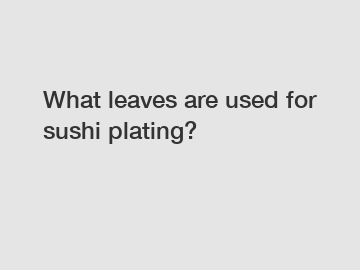Dec. 19, 2023
Food & Beverage
What Leaves are Used for Sushi Plating?
Sushi is an art form that encompasses not only the skillful preparation of the fish and rice but also the visually appealing presentation. One key element in sushi plating is the creative use of leaves. These leaves not only enhance the aesthetic appeal of the dish but also add subtle flavors and textures that complement the sushi. In this article, we will explore the various leaves commonly used in sushi plating and how they contribute to the overall dining experience.
Nori: The Essential Seaweed Wrapper.

No discussion on sushi plating can begin without mentioning the most essential leaf – nori. Nori is a type of edible seaweed that is used to wrap sushi rolls, giving them structure and adding a distinct umami flavor. Nori is harvested, roasted, and then dried into thin sheets before being used in sushi making. Its dark green color and slightly salty taste make it a popular choice for sushi plating. Nori is perfect for creating beautiful sushi rolls with contrasting colors, both inside and out.
Shiso: The Versatile Perilla Leaf.
Shiso, also known as perilla, is a herb native to East Asia. Its beautiful, heart-shaped leaves have a vibrant green or purple color, making them a popular choice for sushi plating. Shiso leaves have a unique flavor that can be described as a mixture of mint, basil, and anise. The fresh and refreshing taste of shiso enhances the overall flavor profile of the sushi and adds a pleasant aroma to the dish. In addition to being used as a decorative element, shiso leaves can also be wrapped around nigiri pieces to provide a burst of flavor.
Further reading:Red Shiso: Adding a Pop of Color.
Red shiso, a variation of the green shiso leaf, is widely used in sushi plating for its striking appearance. While it shares the same fresh and aromatic taste as its green counterpart, the vibrant red color adds a pop of color to the presentation. Red shiso leaves are often used as a base for sashimi platters or as a bed for sushi rolls, creating a visually stunning contrast with the other ingredients. Its unique appearance makes it a favorite among sushi chefs who want to create eye-catching presentations.
Lettuce: An Unexpected Twist.
While lettuce might not be the first leaf that comes to mind when you think of sushi plating, it can surprisingly add an interesting twist to the dish. Crisp and refreshing, lettuce leaves are used as a base or lining for sushi rolls. The mild flavor of lettuce complements the stronger flavors of the fish, rice, and other ingredients, creating a harmonious balance in each bite. Lettuce leaves also provide a satisfying crunch, adding an additional textural element.
Closing paragraph:
In conclusion, the use of leaves in sushi plating is not merely for visual appeal but also plays a significant role in enhancing the overall dining experience. Whether it is the essential nori that wraps the sushi, the versatile shiso leaves that add a burst of flavor, the vibrant red shiso that creates an eye-catching display, or the unexpected twist of lettuce, each leaf contributes to the artistry and taste of sushi. To learn more about sushi plating techniques or to experience a delectable sushi meal, contact us and let our skilled chefs take you on a culinary journey you won't forget.
Want more information on Boiled Bamboo Leaves For Sushi Food, Fresh bamboo leaves vs banana leaves, Sushi Serving Bamboo Tubes? Feel free to contact us.
Further reading:Previous: What is the size of a bamboo leaf?
Next: Bamboo Leaves Edible: Discover the Nutritional Benefits & Exquisite Recipes!
Related Articles
If you are interested in sending in a Guest Blogger Submission,welcome to write for us!
All Comments ( 0 )